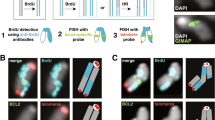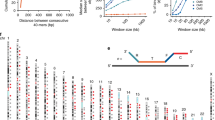Abstract
Following the application of two-color fluorescence in-situ hybridization (FISH) to human interphase cells, we examined the replication timing of the fragile-X locus relative to the non-transcribed late replicating α-satellite region of chromosome-X, a built-in intracellular reference locus. In this assay, an unreplicated locus is identified by a single hybridization signal (singlet; S), whereas a replicated locus is identified by a duplicated signal (doublet; D). Hence, following simultaneous hybridization with the FMR1 and α-satellite probes, male cells with one singlet and one doublet signal per cell (SD cells) indicate S-phase cells where only one of the two loci has replicated. The studied cell samples (lymphocytes and amniocytes) were derived from normal males, fragile-X male patients, and premutation male carriers. Three distinct populations of SD cells were identified among the various samples. The first population had a high frequency of cells showing a doublet FMR1; this pattern, indicating early replication of FMR1, characterized the SD cell population of normal males. The second population had a high frequency of cells showing a singlet FMR1; this pattern, indicating very late replication of FMR1, characterized the SD population of fragile-X patients. The third population had about one half of the cells showing a singlet FMR1 and the other half with a doublet FMR1, indicating somatic variation in the replication timing of FMR1; this pattern was seen in the SD cell population of premutation carriers. The replication status of the FMR1 locus in the cells of patients was altered from late to early in the presence of 5-azadeoxycytidine, an activator of various silent genes. Based on the vast amount of information showing that expressed loci replicate early, whereas unexpressed loci replicate late, we inferred from the replication status of the FMR1 locus that: (1) the normal FMR1 allele is transcriptionally active in lymphocytes and amniocytes; (2) the fully mutated FMR1 allele is transcriptionally silent; (3) the transcriptional activity of the premutated allele is somewhat disturbed; (4) 5-azadeoxycytidine activates the fully mutated FMR1 allele.
Similar content being viewed by others
Author information
Authors and Affiliations
Additional information
Received: 10 June 1997 / Accepted: 5 September 1997
Rights and permissions
About this article
Cite this article
Yeshaya, J., Shalgi, R., Shohat, M. et al. Replication timing of the various FMR1 alleles detected by FISH: inferences regarding their transcriptional status. Hum Genet 102, 6–14 (1998). https://doi.org/10.1007/s004390050647
Issue Date:
DOI: https://doi.org/10.1007/s004390050647




